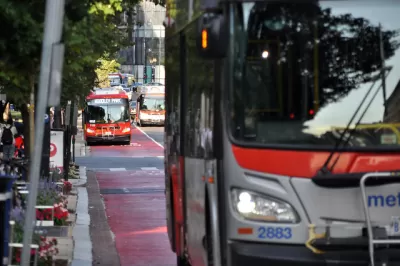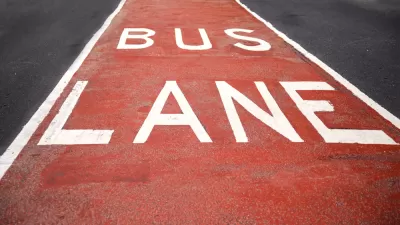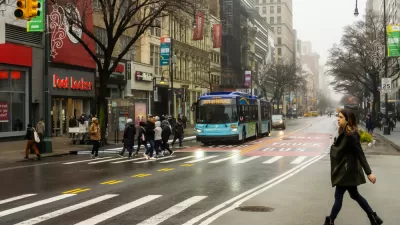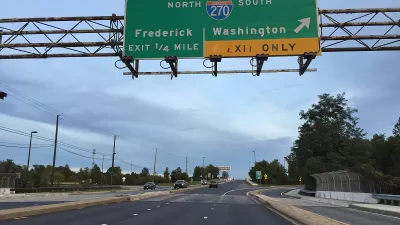Bus lanes covered in a red carpet of paint are gaining popularity in urban areas, but only with a very tentative kind of approval from federal regulators. Red bus lanes took a big, but not final, step toward full regulatory approval in December.

"Federal highway officials are giving communities from the District to San Francisco the green light to paint their roads red," reports Michael Laris.
The Federal Highway Administration had been granting special "experimental" approval to cities like San Francisco; Washington, D.C.; and San Diego, where the new form of transit infrastructure is already in place.
"But last month, the agency, citing years of analysis and appeals from local jurisdictions, said it will give states the go-ahead to paint their transit lanes red if they write seeking permission and follow basic conditions, such as keeping a list of their locations," according to Laris.
The article includes reports from the ground in D.C., where transit officials trumpet the successes of red transit lanes on H and I streets NW downtown. The District Department of Transportation is also planning more red bus lanes "on the heavily traveled 16th Street NW and in all of the city’s eight wards," according to Laris.
"Federal officials left one asterisk in the process," adds Laris, "noting that the promised smoother permissions will still technically be considered 'interim approvals.' That’s because the Manual on Uniform Traffic Control Devices for Streets and Highways, the final word on paint and other standards, is still going through its years-long revision process."
FULL STORY: Federal officials give green light to red bus lanes

Maui's Vacation Rental Debate Turns Ugly
Verbal attacks, misinformation campaigns and fistfights plague a high-stakes debate to convert thousands of vacation rentals into long-term housing.

Planetizen Federal Action Tracker
A weekly monitor of how Trump’s orders and actions are impacting planners and planning in America.

In Urban Planning, AI Prompting Could be the New Design Thinking
Creativity has long been key to great urban design. What if we see AI as our new creative partner?

King County Supportive Housing Program Offers Hope for Unhoused Residents
The county is taking a ‘Housing First’ approach that prioritizes getting people into housing, then offering wraparound supportive services.

Researchers Use AI to Get Clearer Picture of US Housing
Analysts are using artificial intelligence to supercharge their research by allowing them to comb through data faster. Though these AI tools can be error prone, they save time and housing researchers are optimistic about the future.

Making Shared Micromobility More Inclusive
Cities and shared mobility system operators can do more to include people with disabilities in planning and operations, per a new report.
Urban Design for Planners 1: Software Tools
This six-course series explores essential urban design concepts using open source software and equips planners with the tools they need to participate fully in the urban design process.
Planning for Universal Design
Learn the tools for implementing Universal Design in planning regulations.
planning NEXT
Appalachian Highlands Housing Partners
Mpact (founded as Rail~Volution)
City of Camden Redevelopment Agency
City of Astoria
City of Portland
City of Laramie





























